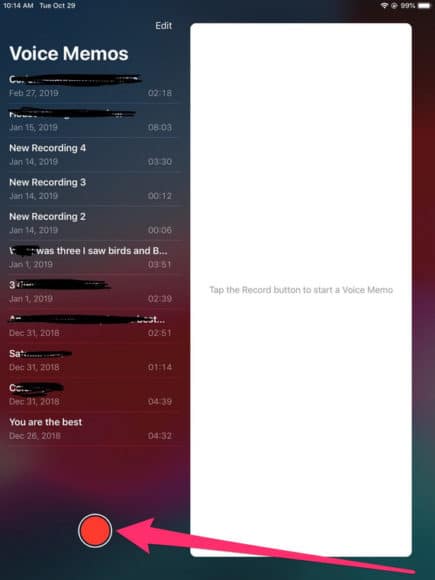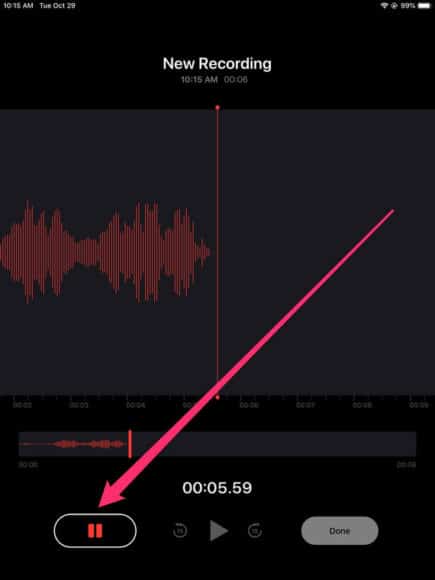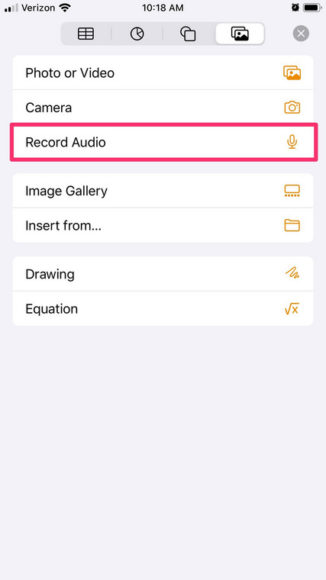Alongside capturing pictures, playing games, browsing e.t.c, your iPad can also create audio recordings for you. With its built-in microphone and applications that come preloaded on lots of iPads, it is possible to record voice memos as reminders for the future, insert sound clips into a presentation, and also record the minutes of a meeting or songs at a music concert.
However, do not think the iPad will capture the jam with album-like quality. But it still captures quality audio with no extra hardware, and the process is not complicated at all.
How Can I Record Audio On My iPad With Voice Memos?
- Click the Voice Memos application to launch it.
- Click the red circle to start recording.
You Might Also Want To Read- How To Fix Your iPad Screen That Is Black?
- Click “pause” to stop recording.
That is that. You can now click the name of the recording and edit it. Click the 3 blue dots beneath the recording if you wish to edit its length, copy it, or share it with others.
How Can I Record Audio In Pages, Keynote, And Numbers On My iPad?
- As soon you have a Pages document, Numbers spreadsheet, or Keynote project open, note where you want to insert an audio recording and click to place your cursor there.
- Click the plus icon way up on the display.
- Be aware that in Numbers, you have one more step- after clicking the plus symbol, you also need to click the icon on the far right of the toolbar that will visible and then choose “Record Audio.”
-
- You Might Also Want To Read:
How To Create A Folder On Your iPad?
- Start dictating or hold the iPad close to the audio source.
- Click “Stop” and then click “Insert.”
You can click and drag the audio icon to hear the recording, and if you wish to have it repositioned for later, just drag the recording around the document, sheet, or project.
More Information About Your iPad
iPad is a line of tablet computers designed, developed and marketed by Apple Inc., which runs the iOS and iPadOS mobile operating systems. The first iPad was released on April 3, 2010; the most recent iPad models are the sixth-generation iPad, released on March 27, 2018; the fifth-generation iPad mini, released on March 18, 2019; the third-generation iPad Air, released on March 18, 2019; and the 11-inch (280 mm) and third-generation 12.9-inch (330 mm) iPad Pro, released on November 7, 2018.
As of May 2017, Apple has sold more than 360 million iPads, though sales peaked in 2013. It is the most popular tablet computer by sales as of the second quarter of 2018.
The user interface is built around the device’s multi-touch screen, including a virtual keyboard. All iPads can connect via Wi-Fi; some models also have cellular connectivity. iPads can shoot video, take photos, play music, and perform Internet functions such as web-browsing and emailing. Other functions – games, reference, GPS navigation, social networking, etc. – can be enabled by downloading and installing apps. As of March 2016, the App Store has more than million apps for the iPad by Apple and third parties.
There have been nine versions of the iPad. The first generation established design precedents, some of which have persisted through all models. The 2nd-generation iPad (iPad 2) introduced a new thinner design, a dual-core Apple A5 processor, and VGA front-facing and 720p rear-facing cameras designed for FaceTime video calling. The third generation added a Retina Display, the new Apple A5X processor with a quad-core graphics processor, a 5-megapixel camera, HD 1080p video recording, voice dictation, and 4G (LTE). The fourth generation added the Apple A6X processor and replaced the 30-pin connector with an all-digital Lightning connector. The iPad Air added the Apple A7 processor and the Apple M7 motion coprocessor, and reduced the thickness for the first time since the iPad 2. The iPad Air 2 added the Apple A8X processor, the Apple M8 motion coprocessor, an 8-megapixel camera, and the Touch ID fingerprint sensor; and further reduced the thickness. The iPad introduced in 2024 added the Apple A9 processor, while sacrificing some of the improvements the iPad Air 2 introduced in exchange for a lower launch price. In 2018, Apple released a 2018 model of iPad with Apple A10 Fusion processor and Apple Pencil support. A year later, the 2019 iPad Air is released, with 10.5-inch display and Apple A12 chip.
There have been five versions of the iPad Mini, all of which have a screen size of 7.9 inches (20 cm). The first generation has similar internal specifications to the iPad 2 but uses the Lightning connector instead. The iPad Mini 2 added the Retina Display, the Apple A7 processor, and the Apple M7 motion coprocessor, closely matching the internal specifications of the iPad Air. The iPad Mini 3 added the Touch ID fingerprint sensor. The iPad Mini 4 features the Apple A8 and the Apple M8 motion coprocessor. The 5th generation features the Apple A12 SoC.
There have been three generations of the iPad Pro. The first generation came with 9.7″ and 12.9″ screen sizes, while the second came with 10.5″ and 12.9″ sizes, and the third with 11″ and 12.9″ sizes. The iPad Pros have unique features such as the Smart Connector, which are exclusive to this series of iPads.





